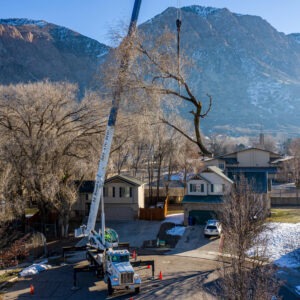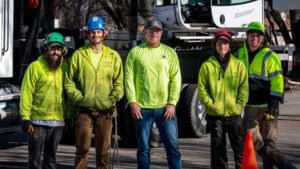In the pursuit of pristine tree trimming, it is paramount to prevent potential pitfalls that could harm your trees or property. Effective tree trimming is vital for maintaining tree vitality, fostering growth, and ensuring safety. By grasping and evading these errors, you can enhance the aesthetic appeal of your trees, mitigate the risk of falling branches, and prevent property damage. Our expert guidance and practical tips will empower both seasoned horticulturists and budding enthusiasts alike in their quest to preserve the beauty and well-being of their trees.
Common Trimming Mistakes
One of the most common pruning mistakes that homeowners make is indiscriminate and excessive pruning, which can result in the weakening and damage of trees. Proper pruning techniques are essential for maintaining the health and structure of trees. When pruning, it is important to consider the branch structure, pruning timing, tree species, tools and equipment, and the benefits of professional tree care.
Understanding the branch structure of a tree is crucial when pruning. Removing large branches or cutting too close to the trunk can lead to significant damage and weaken the tree’s overall structure. It is important to identify the branch collar, which is the swollen area at the base of the branch, and make cuts just outside of it to promote proper healing.
Pruning at the right time is also essential. Different tree species have different growth patterns and should be pruned accordingly. For example, deciduous trees are best pruned during their dormant season, while flowering trees should be pruned after they have finished blooming. Pruning at the wrong time can disrupt the tree’s growth and flowering cycle.
Using the right tools and equipment is important for effective and safe pruning. Sharp, clean pruning shears or saws should be used to make clean cuts and minimize the risk of introducing diseases. It is also important to wear safety equipment, such as gloves and goggles, to protect yourself while pruning.
While homeowners may attempt to prune their trees themselves, it is often beneficial to seek professional tree care. Professional arborists have the knowledge and experience to properly assess and prune trees, ensuring their health and longevity. They can also provide guidance on proper pruning techniques and help homeowners avoid common mistakes.
Improper Cutting Techniques
Using dull blades and making haphazard cuts, as well as neglecting to follow proper pruning guidelines, can result in irreparable damage to your trees. To prevent such damage and ensure the health and longevity of your trees, it is crucial to employ proper cutting techniques. Proper pruning techniques are essential for tree maintenance as they promote healthy tree growth, prevent tree damage, and enhance the overall appearance of your trees.
When it comes to tree trimming, there are a few tips to keep in mind. First and foremost, always use sharp and clean pruning tools to make precise cuts. Dull blades can tear the bark and create wounds that are difficult for the tree to heal. Additionally, it is important to make clean and strategic cuts, avoiding leaving stubs or cutting too close to the trunk or branch collar. Cutting too close to the trunk can damage the tree’s ability to compartmentalize the wound, while leaving stubs can attract pests and diseases.
Following proper pruning guidelines is crucial. Avoid removing more than one-third of the tree’s crown in a single pruning session, as this can stress the tree and hinder its ability to photosynthesize. Instead, opt for a gradual approach, spreading out the pruning over several seasons. It is also important to prune at the right time of year, depending on the type of tree. For most deciduous trees, late winter or early spring, before the onset of new growth, is an ideal time for pruning.
Over-Pruning and Thinning
Excessive pruning can lead to weakened tree structures and diminished foliage density, while thinning too much can disrupt the balance and overall health of your trees. It is important to understand the impact of over-pruning and thinning on the aesthetics and maintenance of your trees.
When it comes to tree aesthetics, over-pruning can result in a sparse and unnatural appearance. Removing too many branches can leave the tree looking bare and unbalanced. On the other hand, thinning too much can create gaps in the tree canopy, affecting its overall shape and density. Striking the right balance is crucial to maintaining the visual appeal of your trees.
In terms of tree maintenance, over-pruning can weaken the tree structure and make it more susceptible to diseases and pests. Removing excessive branches can disrupt the tree’s natural defense mechanisms, leaving it vulnerable to external threats. Similarly, thinning too much can disturb the overall health of the tree. Proper foliage density is essential for photosynthesis and nutrient absorption, and excessive thinning can hinder these processes.
To avoid these issues, it is important to follow proper tree trimming techniques and guidelines. Consult with a professional arborist who can assess the specific needs of your trees and recommend the appropriate pruning methods. They will consider factors such as tree species, age, and overall health to ensure the best outcome.
Neglecting Tree Health and Safety
When it comes to trimming your trees, it is essential to prioritize tree health and safety. Neglecting these aspects can lead to detrimental consequences for both the tree and your property. Proper tree care is crucial for maintaining the overall wellbeing of your trees and ensuring the safety of your surroundings.
Pruning benefits are numerous and should not be overlooked. Regular pruning helps to remove dead or diseased branches, promoting the tree’s health and vitality. It also improves the tree’s shape and appearance, enhancing the aesthetic appeal of your landscape. Additionally, pruning allows for better air circulation around the tree, reducing the risk of fungal infections and other diseases.
To ensure tree health and safety, it is important to follow certain tree care tips. First, make sure to use sharp and clean pruning tools to prevent the spread of diseases. Secondly, avoid over-pruning or removing too many branches at once, as this can weaken the tree and make it more susceptible to damage. It is also crucial to prune at the right time of year, depending on the tree species, to minimize stress and allow for proper healing.
In addition to pruning, there are other tree maintenance practices that contribute to tree health. Regular watering, mulching, and fertilizing are essential for providing the necessary nutrients and moisture to support tree growth. Inspecting trees for signs of pests or diseases and promptly addressing any issues is also crucial for maintaining tree health.
Tree safety precautions should never be overlooked. Before trimming a tree, assess the area for any potential hazards such as overhead power lines or weak branches that could pose a danger. It is advisable to hire a professional tree service if the tree is large or if there are any safety concerns. They have the expertise and equipment to handle the job safely.
Frequently Asked Questions
How Often Should I Trim My Trees?
Regular tree trimming is essential for maintaining healthy and aesthetically pleasing trees. The frequency depends on the tree species and its growth rate. Consulting a professional arborist ensures proper timing and avoids common pruning mistakes.
Can I Trim My Trees Myself or Should I Hire a Professional?
When it comes to trimming trees, it is important to consider the pros and cons of DIY versus hiring a professional. Safety measures, cost-effective options, tree trimming techniques, and expert tips are essential for successful tree trimming.
What Are Some Signs That Indicate My Tree Needs Pruning?
Signs that indicate your tree needs pruning include overgrown branches, dead or diseased limbs, crowded or crossing branches, and excessive canopy density. Pruning benefits include improved tree health, enhanced aesthetics, and reduced risk of property damage. Consulting an arborist for proper pruning techniques is recommended.
Are There Any Specific Tools or Equipment Required for Tree Trimming?
Essential tools for tree trimming include pruning shears, loppers, and a pruning saw. Safety equipment such as gloves, safety glasses, and a hard hat should be worn. Proper techniques and avoiding common mistakes are crucial. The best time for tree trimming varies depending on the tree species.
How Can I Ensure That the Tree Trimming Process Does Not Harm the Overall Health of My Trees?
To ensure the tree trimming process doesn’t harm tree health, it’s crucial to follow proper pruning techniques. Hiring professional tree trimmers offers benefits such as avoiding common mistakes, minimizing risks, and promoting healthy growth after trimming.
Looking for more information? Contact us to talk about your tree trimming options this year!
 Hours: Mon – Fri 8am – 5pm
Hours: Mon – Fri 8am – 5pm +1 801-476-9181
+1 801-476-9181 service@allwoodstreeservice.net
service@allwoodstreeservice.net
